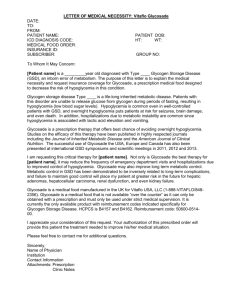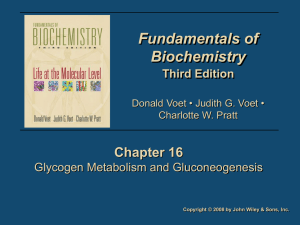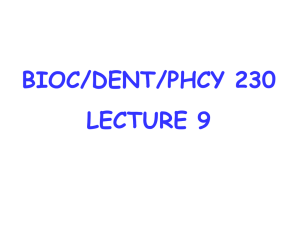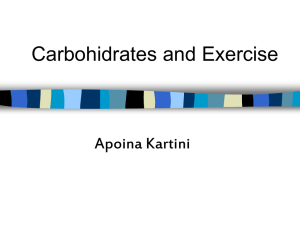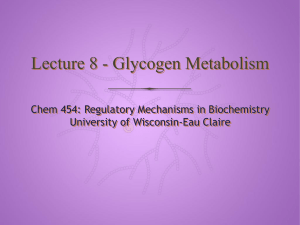unusual euglycemic presentation of glycogen storage disease type 1b
advertisement
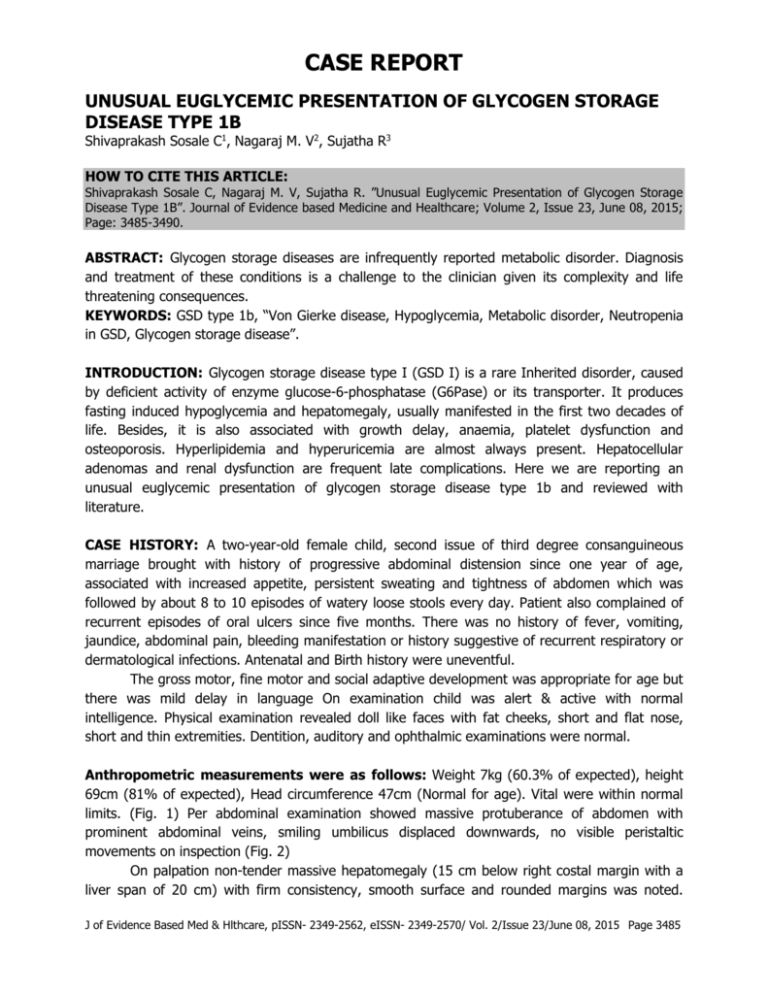
CASE REPORT UNUSUAL EUGLYCEMIC PRESENTATION OF GLYCOGEN STORAGE DISEASE TYPE 1B Shivaprakash Sosale C1, Nagaraj M. V2, Sujatha R3 HOW TO CITE THIS ARTICLE: Shivaprakash Sosale C, Nagaraj M. V, Sujatha R. ”Unusual Euglycemic Presentation of Glycogen Storage Disease Type 1B”. Journal of Evidence based Medicine and Healthcare; Volume 2, Issue 23, June 08, 2015; Page: 3485-3490. ABSTRACT: Glycogen storage diseases are infrequently reported metabolic disorder. Diagnosis and treatment of these conditions is a challenge to the clinician given its complexity and life threatening consequences. KEYWORDS: GSD type 1b, “Von Gierke disease, Hypoglycemia, Metabolic disorder, Neutropenia in GSD, Glycogen storage disease”. INTRODUCTION: Glycogen storage disease type I (GSD I) is a rare Inherited disorder, caused by deficient activity of enzyme glucose-6-phosphatase (G6Pase) or its transporter. It produces fasting induced hypoglycemia and hepatomegaly, usually manifested in the first two decades of life. Besides, it is also associated with growth delay, anaemia, platelet dysfunction and osteoporosis. Hyperlipidemia and hyperuricemia are almost always present. Hepatocellular adenomas and renal dysfunction are frequent late complications. Here we are reporting an unusual euglycemic presentation of glycogen storage disease type 1b and reviewed with literature. CASE HISTORY: A two-year-old female child, second issue of third degree consanguineous marriage brought with history of progressive abdominal distension since one year of age, associated with increased appetite, persistent sweating and tightness of abdomen which was followed by about 8 to 10 episodes of watery loose stools every day. Patient also complained of recurrent episodes of oral ulcers since five months. There was no history of fever, vomiting, jaundice, abdominal pain, bleeding manifestation or history suggestive of recurrent respiratory or dermatological infections. Antenatal and Birth history were uneventful. The gross motor, fine motor and social adaptive development was appropriate for age but there was mild delay in language On examination child was alert & active with normal intelligence. Physical examination revealed doll like faces with fat cheeks, short and flat nose, short and thin extremities. Dentition, auditory and ophthalmic examinations were normal. Anthropometric measurements were as follows: Weight 7kg (60.3% of expected), height 69cm (81% of expected), Head circumference 47cm (Normal for age). Vital were within normal limits. (Fig. 1) Per abdominal examination showed massive protuberance of abdomen with prominent abdominal veins, smiling umbilicus displaced downwards, no visible peristaltic movements on inspection (Fig. 2) On palpation non-tender massive hepatomegaly (15 cm below right costal margin with a liver span of 20 cm) with firm consistency, smooth surface and rounded margins was noted. J of Evidence Based Med & Hlthcare, pISSN- 2349-2562, eISSN- 2349-2570/ Vol. 2/Issue 23/June 08, 2015 Page 3485 CASE REPORT splenomegaly of firm in consistency was noted (8 cm below the left costal margin). Bowel sounds were normal. No rub/ bruit was noticed. Rest of the systemic examination was normal. On investigations, hemogram showed the evidence of mild anaemia (Hb-11.3mg/dl) but significant neutropenia with lymphocytosis. Deranged lipid profile showed increased levels of total cholesterol (222mg/dl), LDL (113mg/dl) and VLDL (61mg/dl), triglycerides (304mg/dl). Increased Uric acid (5.8mg/dl), Lactate level with acidosis was also noted. Serum CPK (78U/L), liver function test, renal parameters and coagulation profile were normal. Echocardiogram was normal and abdominal ultrasound showed hepatosplenomegaly. Surprisingly, 3 to 4 days of continuous blood glucose monitoring and serial overnight fasting blood glucose levels were normal. Liver biopsy showed swollen hepatocytes with vacuolated eosinophilic feathery cytoplasm and rare nuclear hyperglycogenation. PAS stain showed positive for glycogen confirms the diagnosis of glycogen storage disease. (Fig. 3) With administration of glucagon and fructose, there was no change in blood glucose levels but blood lactate level rose remarkably which differentiated the type I from other types of glycogen storage disease. Considering the above investigations with significant neutropenia along with clinical presentation, patient was identified as GSD type 1b with euglycemia. Genetic test for mutation analysis and enzyme study could not done due to non-availability of facility in our country and parents were also uncooperative for further evaluation. Parents were counseled and child was started on corn starch diet. On follow up after three months, gastrointestinal symptoms, appetite and liver size were significantly reduced. DISCUSSION: In human body major part of ingested carbohydrate is absorbed as glucose via the portal system. The glucose is phosphorylated to several intermediate compounds (Glucose 6 phosphate and glucose 1 phosphate) and is ultimately stored as glycogen. Glycogen is an extensively branched polysaccharide formed by glucose units linked together by alpha 1-4 and alpha 1-6 bonds. There is a fall in blood glucose levels with peripheral utilization which leads to depolymerisation of glycogen in liver by enzymatic hydrolytic dephosphorylation releasing free glucose into the blood. The final reaction is mediated by the enzyme glucose 6 phosphatase.1 Glycogen may be stored excessively in the liver and other tissues due to inadequate depolymerisation due to deficiencies of various enzymes or transport proteins required for glycogen metabolism pathways. The glycogen found in these disorders is abnormal in quantity, quality or both. Overall GSD incidence is approximately 1in 20 000 - 43 000 live births with no sex predilection. GSD are classified numerically based on organ involvement and clinical manifestations.2 There are over 12 types and they are classified based on the enzyme deficiency and the affected tissue. Glucose 6 phosphatase deficiency (type1), lysosomal acid alpha glucosidase deficiency (typeII), debranching deficiency (typeIII) and liver phosphorlase kinase deficiency (type Ix) are the most common types that typically present in early childhood.Glycogen storage disease type 1 (GSD1) is commonest type of all and also known as “von Gierke disease,” is an autosomal recessive condition with an incidence of 1 in 100,000. It caused by inherited defects of the glucose-6-phosphatase (G6Pase) complex, which consists of at least 2 membrane proteins, glucose-6-phosphate transporter (G6PT) and G6Pase.3 This complex has a key role in both J of Evidence Based Med & Hlthcare, pISSN- 2349-2562, eISSN- 2349-2570/ Vol. 2/Issue 23/June 08, 2015 Page 3486 CASE REPORT glycogenolysis and gluconeogenesis, converting glucose-6-phosphate (G6P) to glucose. G6PT translocates G6P from the cytoplasm to the lumen of the endoplasmic reticulum; G6Pase catalyzes the hydrolysis of G6P to produce glucose and phosphate. Therefore, to maintain glucose homeostasis G6PT and G6Pase work in concert. Deficiencies in G6Pase (17q21) and G6PT (11q23) cause GSD1a (MIM232200) and GSD1b (MIM232220), respectively. Clinically older infants may present with a doll-like facial appearance, frequent lethargy, and difficult arousal from sleep, tremors, overwhelming hunger, Intermittent diarrhea, growth retardation, protuberant abdomen, relatively thin extremities.4 Episodes of hypoglycemia during periods of fasting occur as stored glycogen is not released. Other features like hepatomegaly, nephropathy, hyperlipidemia, hyperuricemia, and hyperlactacidemia are commonly seen.5 Our case showed similar clinical features and laboratory findings. Majority of reported cases presented with hypoglycemia. But in present case even after serial monitoring, fasting glucose level was normal. Collins JE said in his study that hypoglycemia occurs during fasting as soon as exogenous sources of glucose are exhausted, However, there is evidence that GSD I patients are capable of producing endogenous hepatic glucose to some extent, although the mechanism is still unclear.6 Very rarely, hypoglycemia may be mild, causing a delay in the diagnosis until adulthood, when liver adenomas and hyperuricemia are detected. Long-term complications include gout, hepatic adenomas with risk for malignancy, delayed puberty, osteopenia, platelet dysfunction, pulmonary hypertension, and renal failure. In addition to this Type 1b variant is also associated with recurrent infections due to neutropenia and neutrophil function defect.7 Though we could not see any long term complications may be due to early presentation but significant neutropenia was noted suggestive of type1b.Visser G et al also describes similar case of intermittent diarrhea with oral an intestinal mucosal ulcers in type 1bGSD in his study.8 The diagnosis is based on the clinical presentation, specific constellation of biochemical abnormalities, molecular genetic testing, and/or enzymology in liver biopsy tissue; currently, the increased knowledge of the genetic basis of GSD I make the mutation analysis the method of choice for confirming the diagnosis.9 In general, no specific treatment exists for glycogen storage diseases. There is ongoing research into emerging gene therapy treatments. The principal goal of the treatment is mainly dietary. Current therapy is directed to maintain a nearly euglycemic state to ameliorate secondary metabolic disturbances by continuous or frequent feedings or consumption of uncooked starches, human granulocyte-macrophage colony-stimulating factor (GM-CSF) therapy and assure normal growth. Fewer patients will die as a direct consequence of acute metabolic derangement. Experiences gained over a series of studies demonstrate better secondary metabolic control when the tendency toward hypoglycemic episodes is decreased.10 With ageing, more and more complications will develop of which progressive renal disease and the complications related to liver adenomas are likely to be two major causes of morbidity and mortality. Liver transplantation may be indicated for patients with hepatic malignancy. It is not clear if transplantation prevents further complications. Timely diagnosis and dietary management will prevent the complication and improves the lifestyle of these patients. J of Evidence Based Med & Hlthcare, pISSN- 2349-2562, eISSN- 2349-2570/ Vol. 2/Issue 23/June 08, 2015 Page 3487 CASE REPORT CONCLUSIONS: Glycogen storage disease type I (GSD I) is a rare autosomal recessive disorder of variable clinical severity that primarily affects the liver and kidney. GSD type b is caused by deficiency in the microsomal transport proteins for glucose 6-phosphate (GSD Ib), associated with hepatomegaly, hypoglycemia, lactic acidemia, hyperlipidemia, hyperuricemia, and growth retardation. In addition Patients with type Ib have neutropenia, impaired neutrophil function. Our study emphasizes various distinctive manifestations of these storage diseases. REFERENCES: 1. Robert Mahler, Glycogen storage diseases. J Clin Pathol. 1969 s1-2: 32-41. 2. Hasan Özen, Glycogen storage diseases: New perspectives. World J Gastroenterol. 2007 May 14; 13(18): 2541-2553. 3. Chou JY, Matern D, Mansfield BC, Type I glycogen storage diseases: disorders of the glucose-6-phosphatase complex. Chen YTCurr Mol Med. 2002 Mar; 2(2):121-43. 4. Carvalho et al. Glycogen Storage Disease type 1a – a secondary cause for hyperlipidemia: report of five cases. Journal of Diabetes & Metabolic Disorders 2013, 1-10. 5. Rake JP, Visser G, Labrune P, Leonard JV, Ullrich K, Smit GP, Glycogen storage disease type I: diagnosis, management, clinical course and outcome. Results of the European Study on Glycogen Storage Disease Type I (ESGSD I), Eur J Pediatr. 2002 Oct; 161 Suppl 1:S20-34. Epub 2002 Aug 22. 6. Collins JE, Bartlett K, Leonard JV, Ayynsley-Green A (1990) Glucose production rates in type 1 glycogen storage disease. J Inherit Metab Dis 13:195-206. 7. Visser G et all, Neutropenia, neutrophil dysfunction, and inflammatory bowel disease in glycogen storage disease type Ib: Results of the European Study on Glycogen Storage Disease Type I, The Journal of Pediatrics. Volume 137, Issue 2, August 2000, Pages 187– 191. 8. Visser G, Rake JP, Kokke FT, Nikkels PG, Sauer PJ, Smit GP, Intestinal function in glycogen storage disease type I. J Inherit Metab Dis . 2002 Aug; 25(4):261-7. 9. Froissart R, Piraud M, Boudjemline AM, Vianey-Saban C, Petit F, Hubert-Buron A, Eberschweiler PT, Gajdos V, Labrune P, Glucose-6-phosphatase Deficiency. Orphanet J Rare Dis 2011, 6:27. 10. Wolfsdorf JI, Crigler JF Jr, Effect of continuous glucose therapy begun in infancy on the long-term clinical course of patients with type I glycogen storage disease. J Pediatr Gastroenterol Nutr. 1999 Aug; 29(2):136-43. J of Evidence Based Med & Hlthcare, pISSN- 2349-2562, eISSN- 2349-2570/ Vol. 2/Issue 23/June 08, 2015 Page 3488 CASE REPORT Fig. 1: Doll like facis with growth retardation. Fig. 2: Glycogen storage disease type 1. Liver biopsy showing mosaic pattern, prominent cell membranes and nuclear hyperglycogenation (HE stains). Fig. 2 J of Evidence Based Med & Hlthcare, pISSN- 2349-2562, eISSN- 2349-2570/ Vol. 2/Issue 23/June 08, 2015 Page 3489 CASE REPORT AUTHORS: 1. Shivaprakash Sosale C. 2. Nagaraj M. V. 3. Sujatha R. PARTICULARS OF CONTRIBUTORS: 1. Associate Professor, Department of Paediatrics, Sapthagiri Institute of Medical Sciences and Research Center, Bangalore. 2. Assistant Professor, Department of Paediatrics, Sapthagiri Institute of Medical Sciences and Research Center, Bangalore. 3. Professor, Department of Paediatrics, Sapthagiri Institute of Medical Sciences and Research Center, Bangalore. NAME ADDRESS EMAIL ID OF THE CORRESPONDING AUTHOR: Dr. Shivaprakash Sosale C, Associate Professor, Department of Paediatrics, SIMSRC, Sapthagiri Campus, Bangalore. E-mail: shivaprakashsosale@gmail.com Date Date Date Date of of of of Submission: 02/06/2015. Peer Review: 03/06/2015. Acceptance: 04/06/2015. Publishing: 08/06/2015. J of Evidence Based Med & Hlthcare, pISSN- 2349-2562, eISSN- 2349-2570/ Vol. 2/Issue 23/June 08, 2015 Page 3490



